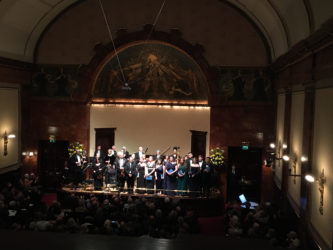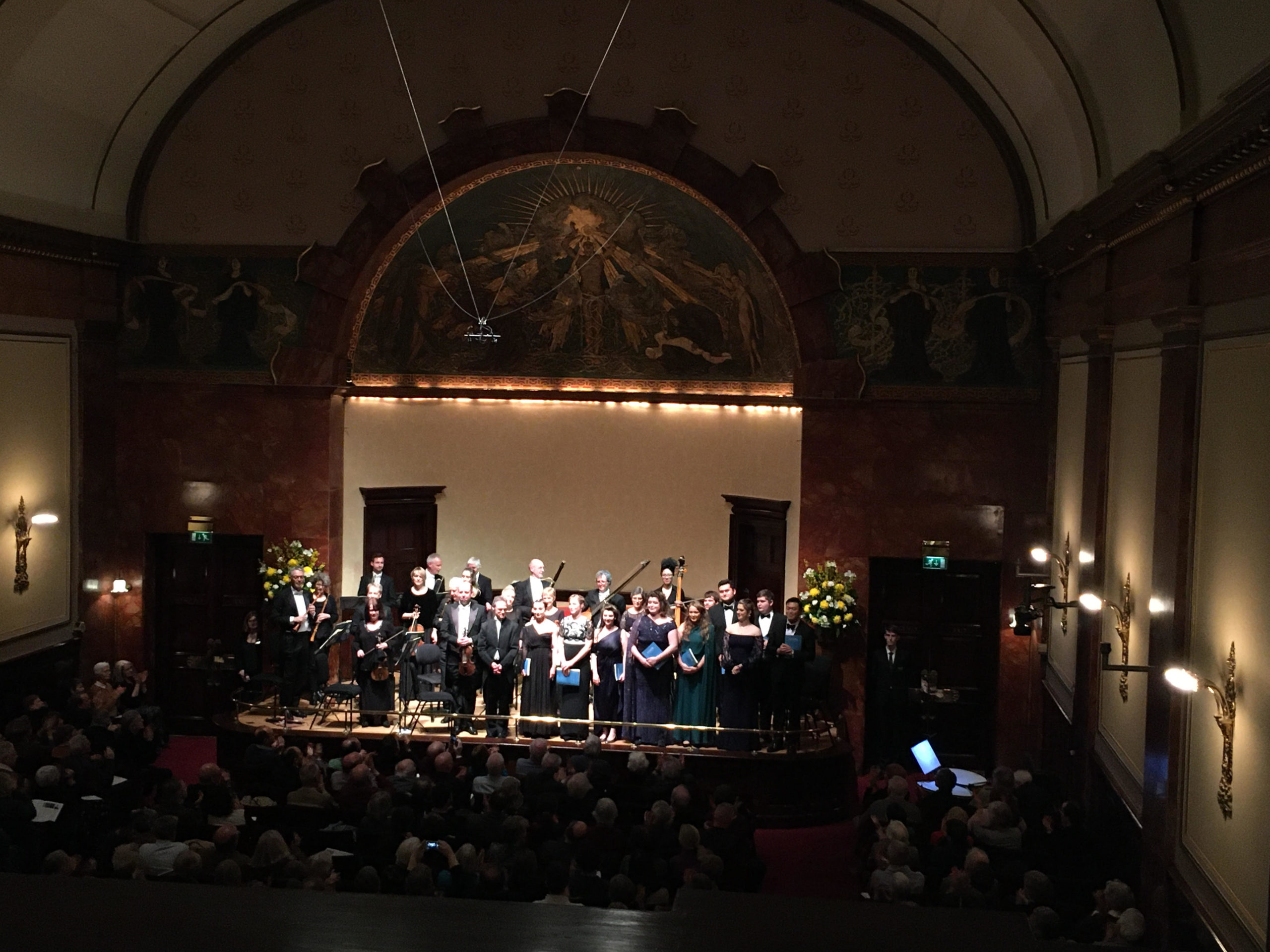 United Kingdom Handel: Katie Bray (mezzo-soprano), Keri Fuge (soprano), Charlotte Bowden (soprano), Jess Dandy (contra-alto), Emily Sierra (alto), Annabel Kennedy (mezzo-soprano), John Lee (bass), London Handel Orchestra / Adrian Butterfield (director). Wigmore Hall, 10.3.2020. (AK)
United Kingdom Handel: Katie Bray (mezzo-soprano), Keri Fuge (soprano), Charlotte Bowden (soprano), Jess Dandy (contra-alto), Emily Sierra (alto), Annabel Kennedy (mezzo-soprano), John Lee (bass), London Handel Orchestra / Adrian Butterfield (director). Wigmore Hall, 10.3.2020. (AK)

Handel – Parnasso in festa HWV73
Parnasso in festa HWV73, composed for the wedding of Princess Anne to Prince William of Orange (London, 1734), was mostly a collection of movements from Handel’s earlier works. Only 10 of the total of 33 numbers plus the overture were newly composed; 20 numbers were borrowed and reshaped from Athalia which was first performed in Oxford the previous summer (1733).
The libretto of Parnasso in festa describes a wedding celebration on the Greek Mount Parnassus which is the home of Apollo and nine muses. In the text by an anonymous author (possibly Giacomo Rossi as suggested by the Halle critical edition of 2017), Apollo features with some of the muses (Clio, Calliope, Euterpe) but also with other characters such as Orpheus (son of Apollo and Calliope), a huntress and two gods. The happy couple whose wedding is celebrated – that is Thetis the sea-nymph and Peleus, King of Myrmidons – do not actually appear in the libretto, they are only referred to. Orpheus’s sadness for having lost his beloved (when he turned back to see her) gets a beautiful aria.
Parnasso in festa is rarely performed although it was staged in Halle in 2018. It is likely that performers as well as most of the audience at this concert performance were new to this ‘Serenata in tre parti’. And what a performance it was! Handel’s melodies and virtuosity filled the packed Wigmore Hall with excitement, marvel and joy. In spite of its length (of slightly over two and half hours including a twenty-minute interval), the audience was spell bound. So much so that nobody clapped between the numbers, yet applause would have been fully justified.
It turned out that, with ingenuity, the Wigmore Hall can be expanded and, compared to its size, can accommodate relatively large performing forces. Thirty-three performers participated and seemed to have enough space to deliver a high-quality performance. Admittedly, the timpani player with his two instruments was placed immediately to the right of the stage in the auditorium. Thanks to Handel, not all wind/brass players are needed all times or at the same time. Thus, for instance, the two horn players entered through a door to the stage when needed and left by the same door when their number concluded. The two trumpet players were accommodated similarly. I cannot be sure how the players knew when to enter from behind the closed door but all entries and departures were smooth, discreet and without any distraction. However, I admit that my dramatic expectations were heightened when I noticed a pair of horns or a pair of trumpets enter (and that my expectations were matched by the music which followed).
The quality of singing was as pleasing as surprising. The majority of singers were students but one could not have guessed their status without reading their biographies in the programme notes. They looked and behaved fully professional in the best sense of the word; they delivered Handel’s music at top level.
Of the students, soprano Charlotte Bowden sang the part of Orfeo. During her first aria (‘Spira al sen’ celeste ardore’ in Part One) I scribbled the words accomplished and musical in my notes. In Part Two, during Orfeo’s accompanied recitative (‘Dopo d’aver perduto il caro bene’) and aria (‘Ho perso il caro ben’) my notes consist of exquisite, pure baroque style and very sensitive. For alto Emily Sierra (as Clori) I noted during her aria (‘Tra sentier di amane selve’) that she was highly competent and sang beautifully. Last but not least, bass John Lee (as Proteo/Mars) gave great pleasure throughout: he is a natural singer with a flexible voice, negotiates top as well as bottom register notes well, he shapes his musical phrases intelligently and creates beautiful vocal lines.
One of the reasons for my attending Parnasso in festa was to hear/see Hungarian mezzo-soprano Eszter Balogh whom I have not yet met/heard. My heart sunk when it was announced immediately before the start of the performance that, owing to laryngitis, Eszter Balogh (due to sing Calliope) had to withdraw and her part was taken on short notice by Jess Dandy. My spontaneous disappointment was soon dispelled by Dandy’s powerful voice, intelligent phrasing and innate musicality; she produced lines, phrases and notes with equal skills. Her penultimate note (d#) in ‘Sempre aspira eccelso core’ (Part Three) was beautifully placed and tuned. It is of note that Jess Dandy first came to study the part and score four days before the performance: a true professional in the best sense of the word.
Although her mind was clearly on the music, in practice mezzo-soprano Katie Bray (as Apollo) gave an unintended masterclass on how to deliver the musical structure of a Handel aria, how to maintain stamina and perfection through mind-blowing virtuoso passages and how to ingrain the music into memory while still keeping contact with the score. The final section of the Serenata, a sustained interaction between Apollo and the choir, was as uplifting as jaw-dropping: joy filled the hall while Katie Bray negotiated her non-stop fast semiquaver passages, seemingly at ease and without needing to take any breath at all.
The ten-piece chorus was spirited, virtuoso, and majestic in their numerous numbers. Polyphony was clear and the voices radiated in the hall. The chorus consisted of the seven soloists plus three gentlemen of evidently also high quality.
The orchestra delivers what it claims to provide: historically informed baroque style playing on baroque instruments (or on copies of baroque originals). Leader Oliver Webber is equally at home in historical research and practical music making. He uses no gimmicks to lead, his playing is clearly understood and absorbed by the other players. The horns played without cracking any of their notes, trumpets too were radiant and perfectly pitched, the oboes dazzled with their virtuosity. Ensemble playing throughout was exemplary.
Much of the praise detailed above should go to Adrian Butterfield who directed the performance. Clearly he was responsible for all tempi, dynamics and much of the phrasing but, most probably, also for the concept from start to finish. Butterfield is not a conductor to throw about his weight during the performance. He is the musical director and, at the same time, fits into the ensemble almost seamlessly. However, there were couple of occasions when I would have preferred no conducting at all. For instance, the duet ‘Sin le grazie nel bel volto’ (Part One) for two solo voices and continuo as well as Orfeo’s aria ‘Da sorgente rilucente’ (Part Three) for solo voice and continuo seemed visually overloaded by conducting. It was a visual matter (for me); the musical concept was in line with the whole of the splendid performance which all of us at the hall fully appreciated and enjoyed.
Agnes Kory
